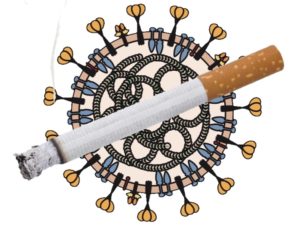

Cigarette smoking appears to be associated with more severe COVID-19, but the underlying mechanisms have not been deciphered. The results of infection of airway cells in culture with SARS-CoV-2 provide some insight.
Smoking is the most important cause of chronic lung disease, which in turn is a risk factor for severe COVID-19. Some studies have identified cigarette smoking as a risk factor for severe COVID-19, and chronic smoke exposure appears to trigger the expansion of cell types in the respiratory tract that produce ACE2, the receptor for SARS-CoV-2. But there have been no direct studies to determine how cigarette smoke affects SARS-CoV-2 infection of the airway epithelium.
To address this question, air-liquid interface cultures of respiratory epithelium from non-smokers were studied. Such cultures are initiated by plating cells taken from the human respiratory tract on a permeable membrane. When medium is removed from the top of the cell layer, it develops into a mucociliary pseudostratified epithelium, similar to the respiratory epithelium. When treated with cigarette smoke and then infected with SARS-CoV-2, these cells in culture produced 2-3 times more viral RNA compared with unexposed cells. Furthermore, the number of infected cells increased in cigarette smoke-treated cultures.
To understand the mechanism by which treatment with cigarette smoke leads to increased viral replication, single-cell RNA sequencing was done to determine the alterations of mRNAs caused by virus infection. This analysis identified a set of genes whose transcription was induced by virus infection of untreated cells, but down-regulated in cigarette smoke-treated cells. These genes encode interferon induced proteins, suggesting that exposure to cigarette smoke impairs an effective innate immune response to infection. In support of this hypothesis, addition of interferon to cultures after treatment with cigarette smoke, but before infection, blocked the production of infectious virus.
These observations do provide some insight into the effect of cigarette smoke on infection of airway epithelial cells with SARS-CoV-2. The finding that viral RNA increased in smoke-treated cells should be extended to determine if the amounts of infectious virus also increases. Blocking virus production with interferon does not illuminate the effect of smoke treatment because this cytokine also blocks infection in untreated cells. It would be more informative to specifically restore the expression of the interferon-induced genes that are reduced by smoke treatment.
Would a 2-3 fold increase in virus production, and a similar increase in the number of infected cells after smoke treatment of these airway cultures, explain why smokers might be a risk for serious COVID-19? A reduced innate immune response might allow substantial viral reproduction in the tract, which could in turn stimulate the over-exuberant immune responses that drive serious COVID-19. However an increase in viral yields alone seems too simplistic to explain the association of serious disease with smoking. An intriguing hint is the effect of cigarette smoke airway basal stem cells, which are important for the repair of damaged airways. Smoke not only increases the number of these cells but also leads to their death. Such an effect could worsen tissue damage in the infected respiratory tract, leading to more severe disease.
